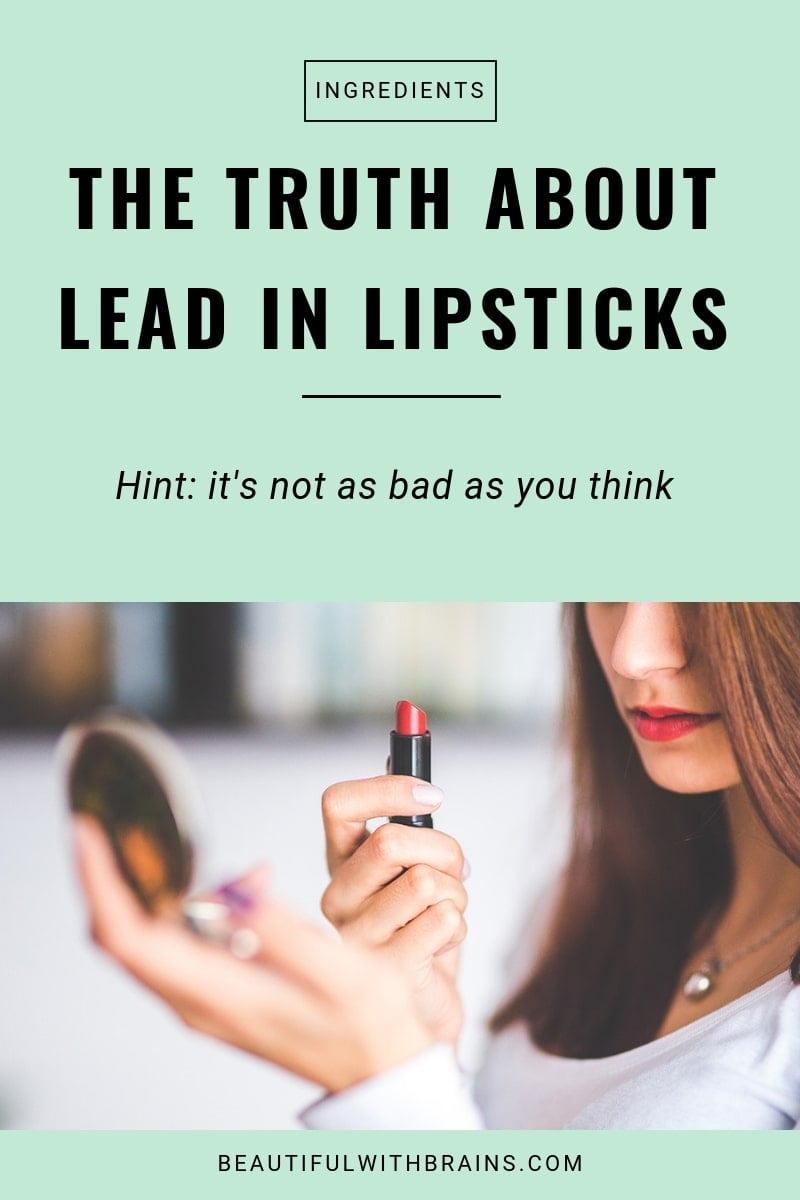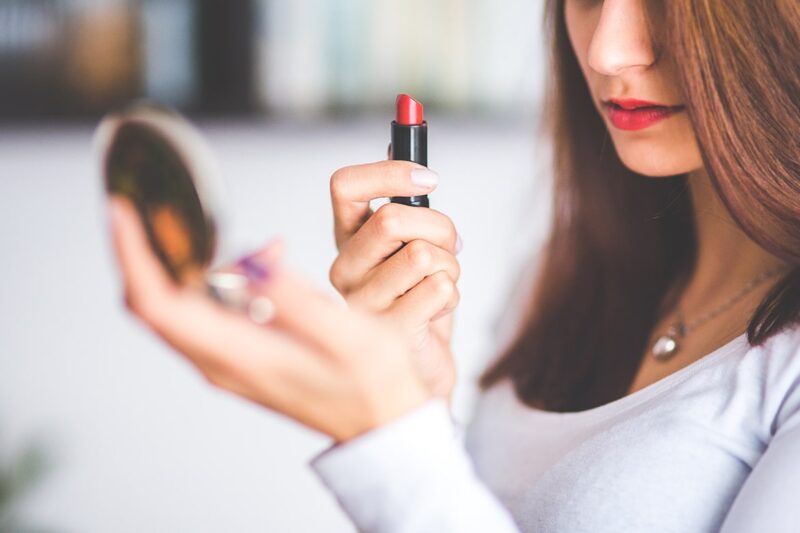
Say what?! There’s lead in my lipstick?!
*throws them all away*
Calm down, ladies!
I know, the rumour is scary. Lead is no joke. It can do you some serious harm. But, no one is going around sprinkling your lipsticks with lead.
Yet, somehow that sneaky little thingie manages to bypass security and slather its way into some of your fave (usually red) shades. How does it do it? Is it a magician or something?
Here’s the truth about lead in lipstick:
What Is Lead?
If you wanna fight the enemy, you must first get to know it. So, what is lead?
Lead is a greyish blue heavy metal that occurs naturally in the earth. Here’s the catch: whoever created the earth didn’t tuck away lead in a box under the oceans or in a volcano’s crater. Nope, they sprinkled it all over the earth. It’s in the soil. In the water. In the air, even.
In other words, lead is present almost everywhere. Through the food chain, it finds its way even on your plates. You’re exposed to it every single day and there’s nothing you can do about it.
Scary, huh?
There’s a silver lining: lead is present in water, food and cosmetics only in trace amounts that don’t pose a threat to human health.
Remember: it’s the dose that makes the poison. Your body knows it’s gonna have to deal with lead and, in small doses, it can quickly neutralise it. It’s when you are exposed to more lead than your body can dispose of that you get cancer.
Want to know what ingredients you really need to avoid in your skincare products? Sign up to the newsletter below to receive the “Skincare Ingredients To Avoid” cheatsheet:
Why Is Lead In My Lipsticks?
If lead is in the soil, it makes sense that everything that grows there, such as veggies and cereals, are contaminated with it.
It’s the same with lipsticks. You won’t find “lead” on any label because it’s not a cosmetic ingredient. No one is adding it to your lipsticks. What they are using is dyes derived from the earth. Some of these dyes, like veggies, happen to contain trace amounts of lead.
Now, let’s be clear: beauty companies can’t use any dye for their lipsticks. They can only use dyes that are approved by the FDA (or the equivalent organisation in your part of the world) for use on the lips.
The FDA imposes a strict limit on the amount of lead that can be found in these dyes: 20ppm (20 parts per million). But most lipsticks contain way less than that.
Why don’t they remove it completely? We don’t have the technology yet. The best we can do for now is limit its use or stop using these particular dyes. But then, red (and many other lipstick) hues would disappear from cosmetic counters (there’s a reason why natural beauty brands only have lipsticks in earthy shades).
One more thing. Each batch of colour made with these dyes must then be controlled and approved by the FDA before it can be sold.

Should You Worry About Lead In Lipsticks?
Remember that email doing the rounds a while ago claiming there was lead in your lipsticks?
Well, the FDA tested those lipsticks and discovered the level of lead was within the guidelines: “FDA found lead in all of the lipsticks tested, ranging from 0.09 ppm to 3.06 ppm with an average value of 1.07 ppm. FDA concludes that the lead levels found are within the range that would be expected from lipsticks formulated with permitted color additives and other ingredients that had been prepared under good manufacturing practice conditions.”
1.07ppm is way below the 20ppm limit. So, there’s A LOT LESS lead in your lipsticks than you think. Phew!
At this point, someone points out that 1.07ppm is still a lot higher than the 0.1ppm allowed in candy. But lipsticks aren’t candy.
Even if you swallow down a bit of colour when you apply lipstick or lick your lips, you’re going to eat WAY less lipstick than candy.
Most of us only apply a thin layer of lipstick. Maybe you retouch it once or twice during the day (if you’re like me, you don’t even bother with that). Lead is distributed all over your lipstick so only the tiniest amount ends up on your lips with each application.
But candy? You swallow the whole thing. Same with a glass of water or a plate of pasta. That’s why the law is stricter with food. It’s the dose that makes the poison, remember?
The Precautionary Principle
“But, Gio,” I hear you say, “if lead is everywhere and I can’t avoid it completely, then shouldn’t I at least avoid it when I can? I need to eat but I don’t need lipstick.”
Look, if that makes you sleep better at night, throw away all your red lipsticks and just use boring neutral shades. But if you’re really concerned about lead, you’d do better to test your water supply or vegetable garden to know how much lead is present in the tap water you drink and the veggies you eat.
As for me, I’m gonna keep rocking my red lipsticks. I’m healthy and I trust my body to deal with the infinitesimally small amount of lead in my lippie.
The Bottom Line
Lead is NOT a cosmetic ingredient. It’s only present in trace amounts in some of the dyes used to create certain shades of (mostly red) lipsticks. This amount is so tiny, it won’t kill you. If you’re really worried about lead, stop wasting your time blaming cosmetics and pay closer attention to what you eat.
What’s your take on lipsticks with lead? Share your opinion in the comments below.

I found the campaign for safe cosmetics to be a fear mongering campaign which made me dislike it. You’re entirely correct, in my opinion, that the miniscule amount of lead found in lipsticks – which are not meant to be ingested – should not be a huge worry. There are more important things to worry about.
Phyrra, I can’t stand the campaign for safe cosmetics either. I’m all for safe cosmetics and in theory their aim is right, but in practice they just like to scare people telling them most ingredients are toxic and carcinogenic without providing any proof at all. Which is not surprising, since science has proved every scary claim they make to be wrong and unfounded.
As for lippies, I agree there are more important things to worry about and using a lipstick with such a minuscule amount of lead won’t harm you at all.
Thanks, Gio! I had no idea. But I’m glad that lipsticks at least have safe amounts of lead as determined by the FDA.
Trisha, you’re welcome. Contrary to popular opinion, cosmetics are very strictly regulated (and rightly so) and they can only contain extremely small concntrations of dangerous ingredients so that they won’t pose any risk to human health.
Most red lipsticks contain higher level of lead because some red pigments are lead-based . I read that report, too, and after that, I don’t even think expensive lipsticks are safer anymore. With that said, the amount of lead in lipsticks is minute. But what makes it controversial is lead accumulates in human bodies. The kidney is the target organ because of its structure. In adults, lead exposure in small quantity does not make such a huge difference but in children, lead exposure does lead to a lot of unwanted developmental problems. I’ve read literatures about children living in lead contaminated residence and low IQ. And guess what? Little girls like to apply and sometimes eat their mommies’ lipsticks and if that lipstick is on the upper end of the list, I think we need to be worried.
The research articles in lead are fun to read because they are so controversial. Until we know its exact mechanism, I guess we should err on the safe side.
Dao, I’m all for safe cosmetics and err on the safe side but I honestly don’t think that lipsticks with lead are dangerous even for kids. Yes, lead in high quantities causes lots of health problems especially in kids but like you pointed out those that were seriosuly affected by it live in lead contaminated areas and are therefore exposed to very high levels of this heavy metal. I don’t think that can be compared to lispticks.
Yes, some little girls like to play with their mum’s lipsticks so if one wants to err on the safe side and ban their daughters from using them that’s fine. But not every kid uses lipstick, a product that’s not meant to be ingested, while every child eats candy and drinks tap water, which are meant to be eaten and drunk, and contain higher levels of lead than lipstick. If a parent is concerned about their children being exposed to lead, they’d rather avoid buying them candy and check the water supply in the house. But getting all paranoid about lipsticks and not worrying at all about what one eats or drinks is just well, silly in my opinion.
I’m with you and Phyrra on the campaign for safe cosmetics. They really are just a bunch of fear mongers, and I think spreading fear is equivalent to spreading hate, but I’m not about to get into that right now.
I’m not too concerned about lead in lipsticks or other cosmetics. If you think about it, almost ll cosmetics contain trace amounts of possibly dangerous chemicals. It’s good to be safe, but why worry when the amounts are so tiny? There are more pressing issues to worry about.
Tammy, I agree with you about the campaign for safe cosmetics. I had thought of briefly mentioning that on this post but it was turning into a very long rant so I left it out. Maybe a should write a post about it..
I agree, most cosmetics contain ingredients that although have side effects at high concentrations are harmless in the tiny amounts used in these products. Besides, even vegs, fruits and water contain small amounts of these ingredients and, unlike cosmetics, food is meant to be ingested. Yet, you don’t hear anyone saying that apples and water are dangerous (because they’re not and neither are cosmetics). Seriosuly people should get informed and get their priorities straight instead than worry about things that are harmless.
really good post! I agree that the comparison they’re using is twisting the facts slightly, you argued it very well! p.s. I really like the picture for this post 🙂
Makeup Morsels, thanks. They are forced to use silly comparisons like that since there are absolutely no proof that lead in cosmetics is dangerous and that’s why they use fear to spread their lies. Otherwise, people would realise how silly their claims are.
I thought that photo would be perfect for the post. 😉
I’m not too concerned about lead in lipstick because I agree that there are bigger things to worry about – like what’s in our food, as you mentioned. I also don’t wear lipstick! I wonder if there’s any lead in lipgloss?
Jeni, I’m not sure about that. No one has ever complained about lipgloss so I didn’t research it. But if they use the same dyes as lipsticks then lead could be in them too. In any case, the amounts would be extremely small too as every ingredient, dyes included, used in cosmetics are strictly regulated to make sure they’re safe so I wouldn’t worry about that either.